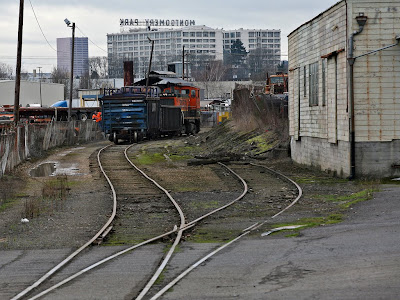 |
| Union Pacific's Lake Transfer freight train at Portland Union Station. |
So here's the deal. You're working second trick at the West Tower of Albina Yard in Portland, Oregon, and you have a mess on your hands. It's 1630, and the Lake Transfer, the train that takes cars from your yard to the Portland Terminal's Lake Yard on the other side of the Willamette River, hasn't left yet. The crew has been on duty since 0630 and they're normally gone by mid-morning. Not today. So their 100+ cars are still choking your yard in the late afternoon, and if you don't get them out soon, that crew is going to die on the federal hours of service law and you'll have to wait for a new crew to arrive before all those cars leave your yard. Not good.
So, you launch the Lake Transfer. It only has to go a couple of miles before it gets out of your hair and becomes the Portland Terminal and BNSF's problem. Now, it's not a small train, and it doesn't move very fast, so while it's slowly dragging itself out of your yard, your next two problems arrive in the form of two southbound departures: the first, and most critical, is power for the nightly Z train out of Brooklyn Yard, a very hot train that carries UPS trailers and a guaranteed departure time. It's not going anywhere until its locomotives get from your yard to Brooklyn. And then you have a southbound train of flatcars heading for Eugene, which is currently sitting on the main line. These trains need to leave.
They can't leave, though, because the Lake Transfer has ground to a halt with its rear end still fouling your all-important 901 control point, the bottleneck through which all these departing trains must pass. The Lake Transfer has stopped because BNSF's Vancouver Terminal dispatcher hasn't cleared it through Portland Union Station yet. That's because Amtrak
Cascades service no. 514 is set to depart any minute, and the BNSF dispatcher doesn't want to risk delaying it by clearing the slow-moving freight ahead of it.
Problem is, Amtrak is waiting for a late-running bus connection. So while it sits, the Lake Transfer sits, the train of flat cars sits, and the all-important power for the Z train sits. And if that power doesn't get to its train soon for the guaranteed departure time, phones are going to start ringing and the voice on the other end isn't going to be wishing you a pleasant good evening.
Now, there's one more little detail in this scenario. The Lake Transfer has the option of going another half mile or so before it reaches the red signal that BNSF won't clear until Amtrak departs. If it moves that extra half mile, it will clear 901 and you can start to run trains. The problem is that it will then be blocking Front Avenue, a downtown Portland street that's running heavy with commuters heading home to their spendy condos that stand on top of the former rail yards all along Union Station.
So, what do you do?
Well, tonight West Tower decided to run the Lake Transfer. With a healthy dose of horns for the Front Avenue crossing, it crept into Union Station and stopped at the big red light at the far end, and like angry water behind a dam, annoyed commuters piled up on both sides of the Front Avenue crossing. The Z train's power got its green signal at 901 and headed for Brooklyn, with the train of flatcars following a few minutes later.
All in all, it worked out pretty well. The late Amtrak bus arrived and its connecting passengers came hurrying onto the platform and into their train, which pulled out just a few moments after the Lake Transfer came to a stop. Once it was gone, the Vancouver Terminal dispatcher cleared the Lake Transfer into Lake Yard, and it was moving again shortly. Total time blocking the Front Avenue crossing was about 15 or 20 minutes. You got to run your trains and those commuters got to complain about the railroad for awhile without having their evenings totally ruined.





























